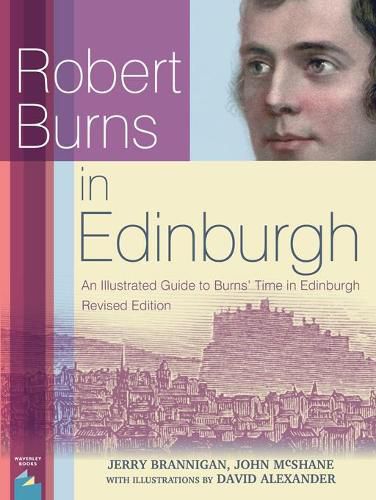Readings Newsletter
Become a Readings Member to make your shopping experience even easier.
Sign in or sign up for free!
You’re not far away from qualifying for FREE standard shipping within Australia
You’ve qualified for FREE standard shipping within Australia
The cart is loading…






A reader-friendly, fully illustrated colour guide to Robert Burns’ time in Edinburgh, with fresh research, maps and illustrations of the key people Burns met, with 27 relevant poems by Burns throughout. With over 100 illustrations by David Alexander and 80 photographs by Jerry Brannigan of key people and places Burns encountered. Easy to follow routes and walking guides in Edinburgh arranged by area and place/people. Tourist information about each site. Robert Burns came to Edinburgh in November 1786 and stayed for 14 months. His book, Poems Chiefly in the Scottish Dialect, Kilmarnock Edition , went on sale on July 31, 1786 and was an immediate success throughout Scotland. Suddenly,he was being spoken of the length and breadth of the land. His plan to emigrateto Jamaica with any profit from the sales of the book was abandoned. Burns’s life was about to change! Dr Thomas Blacklock, known as the Blind Poet, came to know of the book. Blacklock was a much respected poet and critic, acquainted with the cream of literary society in Scotland and he advised Burns to travel to the nation’s capital where a larger edition was promised. Blacklock was sure it would have a more universal circulation than anything else that had been published within his memory . So it was that on November 27, 1786 that Robert Burns, on a borrowed pony, set off on the two-day journey to Edinburgh. It was at the peak of the Scottish Enlightenment. Edinburgh at the time was home to great philosophers, world-renowned economists, engineers, scientists, writers and poets. Enterprise and industry were flourishing. Robert Burns was to find himself thrust into the midst of the social and academic whirlpool that was Edinburgh in 1786, establishing him as a vital part of the Scottish Enlightenment. This book chronicles the places he visited and the brilliant, eccentric, but always fascinating people he met during his stay. Places including Lodge Canongate Kilwinning No. 2, The Kirk of the Canongate, Old Calton Burial Ground, St. Cecilia’s Hall, Pear Tree House, The Luckenbooths and many more. People including, The Duchess of Gordon, Lord Monboddo, James (Balloon) Tytler, Bishop John Geddes, (Indian) Peter Williamson and a host more. Learn of his meeting with a young Sir Walter Scott, and - let’s not forget - Mrs Agnes McLehose, his Clarinda, and inspiration for Ae Fond Kiss. Robert Burns left Edinburgh on March 24, 1788. He was only 29. He was to die in Dumfries eight years later at the age of 37.
$9.00 standard shipping within Australia
FREE standard shipping within Australia for orders over $100.00
Express & International shipping calculated at checkout
A reader-friendly, fully illustrated colour guide to Robert Burns’ time in Edinburgh, with fresh research, maps and illustrations of the key people Burns met, with 27 relevant poems by Burns throughout. With over 100 illustrations by David Alexander and 80 photographs by Jerry Brannigan of key people and places Burns encountered. Easy to follow routes and walking guides in Edinburgh arranged by area and place/people. Tourist information about each site. Robert Burns came to Edinburgh in November 1786 and stayed for 14 months. His book, Poems Chiefly in the Scottish Dialect, Kilmarnock Edition , went on sale on July 31, 1786 and was an immediate success throughout Scotland. Suddenly,he was being spoken of the length and breadth of the land. His plan to emigrateto Jamaica with any profit from the sales of the book was abandoned. Burns’s life was about to change! Dr Thomas Blacklock, known as the Blind Poet, came to know of the book. Blacklock was a much respected poet and critic, acquainted with the cream of literary society in Scotland and he advised Burns to travel to the nation’s capital where a larger edition was promised. Blacklock was sure it would have a more universal circulation than anything else that had been published within his memory . So it was that on November 27, 1786 that Robert Burns, on a borrowed pony, set off on the two-day journey to Edinburgh. It was at the peak of the Scottish Enlightenment. Edinburgh at the time was home to great philosophers, world-renowned economists, engineers, scientists, writers and poets. Enterprise and industry were flourishing. Robert Burns was to find himself thrust into the midst of the social and academic whirlpool that was Edinburgh in 1786, establishing him as a vital part of the Scottish Enlightenment. This book chronicles the places he visited and the brilliant, eccentric, but always fascinating people he met during his stay. Places including Lodge Canongate Kilwinning No. 2, The Kirk of the Canongate, Old Calton Burial Ground, St. Cecilia’s Hall, Pear Tree House, The Luckenbooths and many more. People including, The Duchess of Gordon, Lord Monboddo, James (Balloon) Tytler, Bishop John Geddes, (Indian) Peter Williamson and a host more. Learn of his meeting with a young Sir Walter Scott, and - let’s not forget - Mrs Agnes McLehose, his Clarinda, and inspiration for Ae Fond Kiss. Robert Burns left Edinburgh on March 24, 1788. He was only 29. He was to die in Dumfries eight years later at the age of 37.